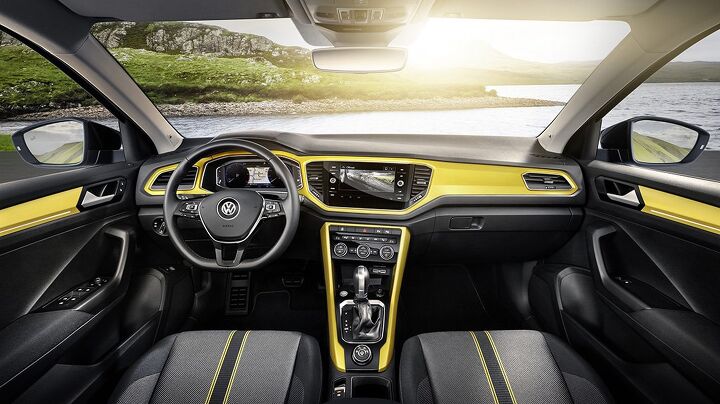Volkswagen T-Roc Is Definitely Not Coming to America Now (and Probably Not Ever)
Volkswagen is perpetually late to the SUV party. That much we knew already. The Volkswagen Touareg came late, and was improperly positioned. The Volkswagen Tiguan was much later, and it too was overpriced and undersized. The Volkswagen Atlas, the brand’s first three-row crossover, only arrived in America this spring.
The Volkswagen T-Roc was clearly not the first guest to arrive, either. The Nissan Juke, Mini Countryman, Subaru Crosstrek, Buick Encore, Chevrolet Trax, Jeep Renegade, Fiat 500X, Honda HR-V, and Mazda CX-3 have been collecting U.S. sales for years. But it’s not as though Volkswagen was the only major automaker late to the party. Ford’s EcoSport still isn’t here, the Hyundai Kona and Kia Stonic were unveiled only recently, and Toyota’s C-HR is a fresh release that lacks an all-wheel-drive option.
But the Volkswagen T-Roc, revealed last week, will be more than just late to the party. In the United States, the Volkswagen T-Roc has returned its invitation by ticking the wrong box. Regret to decline.
Volkswagen of America has confirmed to TTAC that the Volkswagen T-Roc will not come to the United States, probably not ever.
But it’s highly unlikely that Volkswagen will leave the Tiguan Limited — the new de-contented, low-priced Tiguan that’s already been replaced by a new Tiguan — to take the fight to America’s growing fleet of subcompact utility vehicles. Instead, expect a different small utility vehicle, a small crossover that might appeal more directly to the U.S. masses, to set foot on American shores.
Is the T-Roc too small, too big, too costly, too… something to earn its way against the Jeep Renegade and Honda HR-V and Buick Encore? Volkswagen won’t say precisely why the T-Roc is unfit for U.S. duty. The decision is an odd one. Five months ago, after Volkswagen’s U.S. boss Hinrich Woebcken acknowledged the brand’s woeful under-representation in the U.S. SUV/crossover sector, reports suggested Volkswagen’s U.S. dealer network was entirely ready to sell T-Rocs.
So far this year, only 14 percent of Volkswagen’s U.S. volume is derived from utility vehicles. More than 40 percent of the vehicles now sold in America are SUVs/crossovers.
Yet Volkswagen is now pointing out that most small utility vehicles sold globally are sold in Europe and China. To be fair, the U.S. subcompact crossover market is small. With fewer than 320,000 sales through 2017’s first seven months, the subcompact crossover sector generates far fewer sales than the Toyota RAV4 and Honda CR-V, which combined for nearly 450,000 sales during the same period.
But it is a growth sector, and it’s one that Volkswagen appears perfectly willing to neglect, at least for a little while longer. According to Bloomberg, Volkswagen plans seven new utility vehicles by the end of next year.
[Image: Volkswagen]
Timothy Cain is a contributing analyst at The Truth About Cars and Autofocus.ca and the founder and former editor of GoodCarBadCar.net. Follow on Twitter @timcaincars.
More by Timothy Cain
Latest Car Reviews
Read moreLatest Product Reviews
Read moreRecent Comments
- ToolGuy "Nothing is greater than the original. Same goes for original Ford Parts. They’re the parts we built to build your Ford. Anything else is imitation."
- Slavuta I don't know how they calc this. My newest cars are 2017 and 2019, 40 and 45K. Both needed tires at 30K+, OEM tires are now don't last too long. This is $1000 in average (may be less). Brakes DYI, filters, oil, wipers. I would say, under $1500 under 45K miles. But with the new tires that will last 60K, new brakes, this sum could be less in the next 40K miles.
- BeauCharles I had a 2010 Sportback GTS for 10 years. Most reliable car I ever own. Never once needed to use that super long warranty - nothing ever went wrong. Regular maintenance and tires was all I did. It's styling was great too. Even after all those years it looked better than many current models. Biggest gripe I had was the interior. Cheap (but durable) materials and no sound insulation to speak of. If Mitsubishi had addressed those items I'm sure it would have sold better.
- Marty S I learned to drive on a Crosley. Also, I had a brand new 75 Buick Riviera and the doors were huge. Bent the inside edge of the hood when opening it while the passenger door was open. Pretty poor assembly quality.
- 3-On-The-Tree Alan, I was an Apache pilot and after my second back surgery I was medically boarded off of flying status due to vibrations, climbing on and off aircraft, so I was given the choice of getting out or re-branching so I switched to Military Intel. Yes your right if you can’t perform your out doesn’t matter if your at 17 years. Dad always said your just a number, he was a retired command master chief 25 years.



































Comments
Join the conversation
It's nice to see the CUV craze lose one, makes me smile. Stick with it VW. And hey, site admins, WordPress 4.8.1 is available. Just thought I'd let you know!
I get it, maybe at current sales volume the subcompact crossover segment doesn't pencil out. Last year the entire segment was just over 500k. The range of sales varied from 10-20k for the Fiat, Mini, and Mazda to about 100k for the Jeep and Subaru. However, VW sales have been in decline since 2012. Maybe they passed because they know the market has peaked and this would much likelier Ben selling closer to 10-20k a year than 100k. My question is how do we know if the shift towards crossovers has ended/stabilized. What's if car sales fall further? Wouldn't VW want to offer thisnfor that contingency.